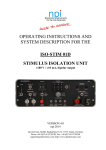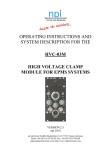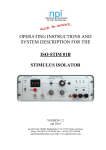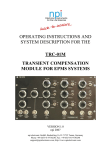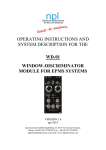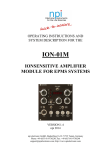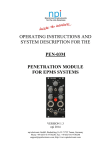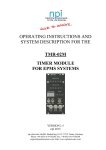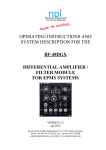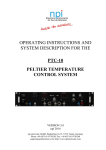Download OPERATING INSTRUCTIONS AND SYSTEM DESCRIPTION OF
Transcript
OPERATING INSTRUCTIONS AND SYSTEM DESCRIPTION OF THE ISO-STIM 01M STIMULUS ISOLATION UNIT FOR EPMS SYSTEMS VERSION 3.8 npi 2013 npi electronic GmbH, Bauhofring 16, D-71732 Tamm, Germany Phone +49 (0)7141-9730230; Fax: +49 (0)7141-9730240 [email protected]; http://www.npielectronic.com ISO-STIM 01M User Manual _________________________________________________________________________________________________________________ Table of Contents 1. Safety Regulations .............................................................................................................. 3 2. Special Safety Notice for High Voltage Instruments.......................................................... 4 3. EPMS-07 Modular Plug-In System .................................................................................... 5 3.1. General System Description / Operation ..................................................................... 5 3.2. EPMS-07 Housing ....................................................................................................... 5 3.3. EPMS-E-07 Housing ................................................................................................... 5 3.4. PWR-03D .................................................................................................................... 5 3.5. System Grounding ....................................................................................................... 6 3.6. Technical Data ............................................................................................................. 6 4. ISO-STIM 01M Stimulus Isolation Unit ............................................................................ 7 4.1. System Description ...................................................................................................... 7 4.2. Description of the Front Panel ..................................................................................... 8 5. Modes of Operation ............................................................................................................ 13 GATE TTL INPUT MODE: ....................................................................................... 13 DIRECT INPUT MODE: ............................................................................................ 13 ANALOG INPUT MODE:.......................................................................................... 13 BIPOLAR .................................................................................................................... 14 OPERATION IN THE 10 mA (max.) RANGE .......................................................... 14 6. Test Procedures ................................................................................................................... 16 6.1. DIRECT mode ............................................................................................................. 16 6.2. TTL trigger mode ........................................................................................................ 16 6.3. ANALOG trigger mode ............................................................................................... 16 7. Technical Data .................................................................................................................... 17 ___________________________________________________________________________ version 3.8 page 2 ISO-STIM 01M User Manual _________________________________________________________________________________________________________________ 1. Safety Regulations VERY IMPORTANT: Instruments and components supplied by npi electronic are NOT intended for clinical use or medical purposes (e.g. for diagnosis or treatment of humans), or for any other life-supporting system. npi electronic expressively disclaims any warranties for such purpose. Equipment supplied by npi electronic shall be operated only by selected, trained and adequately instructed personnel. For details please consult the GENERAL TERMS OF DELIVERY AND CONDITIONS OF BUSINESS of npi electronic, D-71732 Tamm, Germany. 1) GENERAL: This system is designed for use in scientific laboratories and should be operated by trained staff only. General safety regulations for operating electrical devices are to be considered. 2) AC MAINS CONNECTION: While working with the npi systems, always adhere to the appropriate safety measures for handling electronic devices. Before using any device please read manuals and instructions carefully. The device is to be operated only at 115/230 Volt 60/50 Hz AC. Please check for appropriate line voltage before connecting any system to mains. Always use a three-wire line cord and a mains power-plug with a protection contact connected to ground (protective earth). Before opening the cabinet disconnect mains power-plug. Disconnect mains power-plug when replacing the fuse or changing line voltage. Replace fuse only with an appropriate specified type. 3) STATIC ELECTRICITY: Electronic equipment is sensitive to static discharges. Some devices such as sensor inputs are equipped with very sensitive FET amplifiers, which can be damaged by electrostatic charge and must therefore be handled with care. This can be avoided by touching a grounded metal surface when changing or adjusting sensors. Always turn power off when adding or removing modules, connecting or disconnecting sensors, headstages or other components from the instrument or 19” cabinet. 4) TEMPERATURE DRIFT / WARM-UP TIME: All analog electronic systems are sensitive to temperature changes. Therefore, all electronic instruments containing analog circuits should be used only in a warmed-up condition (i.e. after internal temperature has reached steady-state values). In most cases a warm-up period of 20-30 minutes is sufficient. 5) HANDLING: Please protect the device from moisture, heat, radiation and aggressive chemicals. 6) SPECIAL WARNING: THIS INSTRUMENT HAS A HIGH VOLTAGE OUTPUT (PINS MARKED ISOLATED OUTPUT, CAUTION HIGH VOLTAGE). Do not touch these pins, nor not insulated wires connected to these pins. Always turn power off if you manipulate devices connected to these pins. ___________________________________________________________________________ version 3.8 page 3 ISO-STIM 01M User Manual _________________________________________________________________________________________________________________ 2. Special Safety Notice for High Voltage Instruments HIGH VOLTAGE!! RISK OF ELECTROCUTION!! Observe extreme caution when working with this instrument!!! 1) Always connect high voltage power supplies to protective earth!! 2) Do not touch connections unless the instrument is turned off and the capacitance of both the load and power supply are earthed!! 3) Allow adequate time for discharge of internal capacitance of the power supply!! 4) Do not ground yourself or work under wet or damp conditions!! 5) Servicing should be only done by qualified personnel aware of the hazards!! 6) If in doubt, return to supplier for servicing!! ___________________________________________________________________________ version 3.8 page 4 ISO-STIM 01M User Manual _________________________________________________________________________________________________________________ 3. EPMS-07 Modular Plug-In System 3.1. General System Description / Operation (1) The npi EPMS-07 is a modular system for processing of bioelectrical signals in electrophysiology. The system is housed in a 19” rackmount cabinet (3U) has room for up to 7 plug-in units. The plug-in units are connected to power by a bus at the rear panel. (2) The plug-in units must be kept in position by four screws (M 2,5 x 10). The screws are important not only for mechanical stability but also for proper electrical connection to the system housing. Free area must be protected with covers. 3.2. EPMS-07 Housing The following items are shipped with the EPMS-07 housing: EPMS-07 cabinet with built-in power supply Mains cord Fuse 2 A / 1 A, slow Front covers (3) In order to avoid induction of electromagnetic noise the power supply unit, the power switch and the fuse are located at the rear of the housing. 3.3. EPMS-E-07 Housing The following items are shipped with the EPMS-E-07 housing: EPMS-E-07 cabinet External Power supply PWR-03D Power cord (PWR-03D to EPMS-E-07) Mains chord Fuse 1.6 A / 0.8 A, slow Front covers The EPMS-E-07 housing is designed for low-noise operation, especially for extracellular and multi channel amplifiers with plugged in filters. It operates with an external power supply to minimize distortions of the signals caused by the power supply. 3.4. PWR-03D The external power supply PWR-03D is capable of driving up to 3 EPMS-E housings. Each housing is connected by a 6-pole cable from the one of the three connectors on the front panel of the PWR-03D to the rear panel of the respective EPMS-E housing. (see Figure 1, Figure 3). A POWER LED indicates that the PWR-03D is powered on (see Figure 1). Power switch, voltage selector and fuse are located at the rear panel (see Figure 2). Note: The chassis of the PWR-03D is connected to protective earth, and it provides protective earth to the EPMS-E housing if connected. ___________________________________________________________________________ version 3.8 page 5 ISO-STIM 01M User Manual _________________________________________________________________________________________________________________ Figure 1: PWR-03D front panel view Figure 2: PWR-03D rear panel view Note: This power supply is intended to be used with npi EPMS-E systems only. 3.5. System Grounding EPMS-07 The 19" cabinet is grounded by the power cable through the ground pin of the mains connector (= protective earth). In order to avoid ground loops the internal ground is isolated from the protective earth. The internal ground is used on the BNC connectors or GROUND plugs of the modules that are inserted into the EPMS-07 housing. The internal ground and mains ground (= protective earth) can be connected by a wire using the ground plugs on the rear panel of the instrument. It is not possible to predict whether measurements will be less or more noisy with the internal ground and mains ground connected. We recommend that you try both arrangements to determine the best configuration. EPMS-E-07 The 19" cabinet is connected to the PROTECTIVE EARTH connector at the rear panel. The chassis is linked to protective earth only if the PWR-03D is connected. It can be connected also to the SYSTEM GROUND (SIGNAL GROUND) on the rear panel of the instrument (see Figure 3). Important:: Always adhere to the appropriate safety measures. Figure 3: Rear panel connectors of the EPMS-E-07 3.6. Technical Data 19” rackmount cabinet, for up to 7 plug-in units Dimensions: 3U high (1U=1 3/4” = 44.45 mm), 254 mm deep EPMS-07 Power supply: 115/230 V AC, 60/50 Hz, fuse 2 A / 1 A slow, 45-60 W EPMS-E-07 External power supply (for EPMS-E): Dimensions of External power supply: 115/230 V AC, 60/50 Hz, fuse 1.6/0.8 A, slow (W x D x H) 225 mm x 210 mm x 85 mm ___________________________________________________________________________ version 3.8 page 6 ISO-STIM 01M User Manual _________________________________________________________________________________________________________________ 4. ISO-STIM 01M Stimulus Isolation Unit 4.1. System Description The ISO-STIM 01M stimulus isolation unit is a plug-in unit for the npi EPMS-07 modular system. It is designed for application of extracellular stimuli, e.g. in brain slices. The output signal is optically separated from ground and can either be a constant voltage up to 100 V or a constant current up to 10 mA. The ISO-STIM 01M has a built-in timing unit with adjustable pulse length, amplitude and polarity. The ISO-STIM 01M has three modes of operation: 1. In the DIRECT input mode the output signal follows exactly the input signal. 2. In the GATE TTL input mode the output signal is generated by the build-in timing unit and triggered either by a TTL trigger at the GATE TTL connector or manually with the MAN. TRIGGER switch. 3. In the ANALOG input mode the output signal follows – like in direct mode – the input signal but is triggered by the input signal itself and the duration of the output stimulus is set at the ISO-STIM 01M. Two LEDs to indicate if the amplifier is 10% below its positive or negative limit (limit is ±100 V or 10 mA respectively), and one LED to indicate the application of a voltage or current stimulus. Three trim-pots allow compensation of electrode artifacts (CAP.COMP., OFFSET) and for electronic offsets (BALANCE). SPECIAL WARNING: THIS INSTRUMENT HAS A HIGH VOLTAGE OUTPUT (PINS MARKED ISOLATED OUTPUT, CAUTION HIGH VOLTAGE). Do not touch these pins nor bare wires connected to this pins. Always turn power off if you manipulate devices connected to these pins. ___________________________________________________________________________ version 3.8 page 7 ISO-STIM 01M User Manual _________________________________________________________________________________________________________________ 4.2. Description of the Front Panel Figure 4: ISO-STIM 01M front panel view (1), (2) OUTPUT MODE switches (1) BIPOLAR ON / BIPOLAR OFF switch Two position switch for selecting the signal OUTPUT mode. Upper position: BIPOLAR ON, Lower position: BIPOLAR OFF. ___________________________________________________________________________ version 3.8 page 8 ISO-STIM 01M User Manual _________________________________________________________________________________________________________________ (2) VOLTAGE / CURRENT switch Two position switch for selecting the isolator OUTPUT mode. Upper position: VOLTAGE, Lower position: CURRENT. Important: If the CAP.COMP. (#5) is overcompensated in CURRENT MODE the stimulus isolator will ring and not work properly! (3) OFFSET trim-pots OFFSET (C) trim-pot T Trim-pot to compensate for the CURRENT OFFSET of the stimulating electrode in all input modes. It is recommended to compensate the offsets only in a completely warmed up condition, i.e. after 30 minutes warm-up time . OFFSET (V) trim-pot Trim-pot to compensate for the VOLTAGE OFFSET of the stimulating electrode in TTL mode. It is recommended to compensate the offsets only in a completely warmed up condition i.e. after 30 minutes warm-up time. Compensation procedure is the same for current and voltage in the TTL MODE. (4) BALANCE trim-pot Trim-pot for compensating for baseline differences of the stimulus when switching from DIRECT to GATE TTL mode or vice versa. Even if no stimulus is applied in DIRECT MODE or ANALOG MODE, the baseline of the stimulus isolator may not be zero. Using this trim pot the stimulus output can be balanced to zero. OFFSET / BALANCE adjustment First, the voltage source OFFSET is compensated in TTL mode using the VOLTAGE OFFSET trim pot #18. The same procedure is repeated in TTL mode for current source OFFSET, if the ISO-STIM 01D is in CURRENT mode using the CURRENT OFFSET trim pot #17. If these baselines are set, the isolation amplifiers may still produce a signal in ANALOG or DIRECT mode even if no stimulus is applied. This offset signal is balanced to zero using the BALANCE trim pot. (5) CAP.COMP. trim-pot Potentiometer that compensates for the input capacitances in isolated current output operation. Capacity compensation is achieved by turning the potentiometer with a small screw driver clockwise until the current signal at the oscilloscope is as square as possible. Important: If the CAP.COMP. is overcompensated in CURRENT MODE the stimulus isolator will ring and not work properly! ___________________________________________________________________________ version 3.8 page 9 ISO-STIM 01M User Manual _________________________________________________________________________________________________________________ (6) CHASSIS jack Jack linked to the CHASSIS. The green banana connector of the supplied cable is connected here. (7), (8) ISOLATED OUTPUT jacks Jacks providing the ISOLATED OUTPUT signal. The polarity of the input of the +,0,- switch (#19, Figure 4) respectively is not changed, i.e. the red plug is positive (+) if the output polarity switch is set to + or the input signal is positive. This signal is completely isolated from earth. The black jack serves as reference point for the isolated output signal. The black banana connector of the supplied cable is connected to the black jack and the red to the red jack. WARNING: THIS INSTRUMENT HAS A HIGH VOLTAGE OUTPUT (UP TO 100 V). Do not touch these pins or bare wires connected to these pins. Always turn power off if you manipulate devices connected to these pins. (9), (10) STIMULUS INDICATOR (9) STIMULUS INDICATOR LED Yellow LED indicating that a stimulus is applied. (10) STIMULUS INDICATOR BNC BNC connector providing a TTL signal whenever a stimulus is applied. (11) MAN. TRIGGER button Button for triggering the isolator in GATE TTL INPUT MODE manually. (12) SIGNAL INPUT BNC BNC connector for the analog INPUT SIGNAL. The signal is transformed into the isolated output signal and amplified by a factor of ten (see also chapter 5). ___________________________________________________________________________ version 3.8 page 10 ISO-STIM 01M User Manual _________________________________________________________________________________________________________________ (13) GATE TTL BNC BNC connector for triggering the stimulus isolator in GATE TTL INPUT MODE (see also chapter 5). (14) INPUT MODE switch Three position switch to set the operating mode of the stimulus isolator either to ANALOG, to GATE TTL or to DIRECT INPUT MODE(see also chapter 5). (15) TIME BASE RANGE switch Three position switch to set the time base of the built-in timing unit. Available ranges: 10-99 µs (lower position), 100-999 µs (middle position), 1-99 ms (upper position). (16) DURATION potentiometer 2-digits, digital potentiometer to set the stimulus duration in GATE TTL INPUT MODE. The stimulus duration is the reading of this potentiometer multiplied by the factor set with switch #16. Note: Setting of 00 as duration is not defined and should not be set!! (17, 18) OVER LEDs LEDs indicating when the isolator exceeds it’s linear range limit (±90 V or 9 mA respectively). ___________________________________________________________________________ version 3.8 page 11 ISO-STIM 01M User Manual _________________________________________________________________________________________________________________ (19) + / 0 / - switch Switch for setting the polarity of the output signal in GATE TTL INPUT MODE. In “0” position the internal stimulus generation is disabled Note: In ANALOG or DIRECT INPUT MODE this switch must be in 0 position. (20) CURRENT RANGE switch Three position rotary switch to set the current range of the build-in timing unit. Available ranges: 0.1-99.9 µA (lower position), 1-999 µA (middle position), 10-9999 µA (upper position). (21) AMPLITUDE potentiometer Ten-turn potentiometer for setting the AMPLITUDE of the output signal. Range in VOLTAGE mode: 0.1-99.9 V. Amplitude in CURRENT mode is the reading of this potentiometer multiplied by the factor set with switch #20. ___________________________________________________________________________ version 3.8 page 12 ISO-STIM 01M User Manual _________________________________________________________________________________________________________________ 5. Modes of Operation GATE TTL INPUT MODE: In this mode the output signal is generated by the build-in timing unit. It is triggered either manually via the MANUAL TRIGGER switch or via a TTL pulse at the GATE TTL BNC connector. The duration of the pulse is set at the DURATION thumb wheel switch and the 3position range switch below. The duration time is determined by reading of the thumb wheel switch multiplied by the factor set via the range switch. The minimum duration is 10 µs, the maximum is 99 ms. The amplitude of the pulse is set by the AMPLITUDE thumb wheel switch. The reading of this switch is multiplied by 0.1 V in VOLTAGE OUTPUT MODE. In CURRENT OUTPUT MODE the reading is multiplied by the factor set with the CURRENT RANGE switch. For example, 250 at the thumb wheel switch will give 25 V or 250 µA (CURRENT RANGE switch in position x1 µA) at the output plugs depending on the setting at the OUTPUT MODE switch. If the CURRENT RANGE switch is in position x10 µA, 250 at the thumb wheel switch will give 2.5 mA at the output plugs. DIRECT INPUT MODE: The signal fed into the SIGNAL INPUT connector is transformed into the isolated output signal and amplified by a factor of ten (OUTPUT MODE: VOLTAGE), i.e. an input of 1 V will lead to an output stimulus of 10 V. In CURRENT OUTPUT MODE the amplitude of the output stimulus is again dependent on the setting the CURRENT RANGE switch. With the CURRENT RANGE switch in position x1 µA, an input voltage of 1 V will result in an output stimulus of 100 µA, and with the CURRENT RANGE switch in position x10 µA the output current will be 1 mA. The polarity switch must be in 0 position! The frequency of the input signal should not exceed 4 kHz. ANALOG INPUT MODE: The signal fed into the SIGNAL INPUT connector will be isolated from earth and amplified (OUTPUT MODE: voltage) as in the DIRECT INPUT MODE. The trigger level is set to 300 mV, i.e. the input signal must have an amplitude of 300 mV or more. If the trigger level is exceeded the input signal is transformed to the isolated output plugs, and the output stimulus follows the input signal as long as set by the DURATION thumb wheel. Figure 5 gives some examples how the different input modes work. Please note that this figure does not show original recorded data. It’s for illustration only ___________________________________________________________________________ version 3.8 page 13 ISO-STIM 01M User Manual _________________________________________________________________________________________________________________ BIPOLAR The isolator is capable to generate biphasic stimuli by switching the stimulus mode switch to BIPOLAR ON. In this mode, the stimulus that is set by the user, will be followed by a second stimulus with the same amplitude and duration, but with reverse polarity. There is no delay between first and second part of the stimulus. For instance, if the user sets a positive stimulus of +1 V amplitude and 100 µs duration, this stimulus will be followed immediately by a negative stimulus of –1 V and 100 µs duration. OPERATION IN THE 10 mA (max.) RANGE According to Ohm’s law, with 100 V voltage 10 mA current can be achieved only if the resistance of the stimulus electrode is not higher than 10 k. Otherwise the current will be less. The output is short-circuit protected with a 1 k resistor. This implicates that when using low resistance stimulation electrodes with high current flow, there is a voltage drop at this resistor. CAUTION: This means that in voltage operation mode the output swing is reduced due to the voltage divider between the electrode resistance and the protection resistor. ___________________________________________________________________________ version 3.8 page 14 ISO-STIM 01M User Manual _________________________________________________________________________________________________________________ Figure 5: Modes of operation (illustration only) ___________________________________________________________________________ version 3.8 page 15 ISO-STIM 01M User Manual _________________________________________________________________________________________________________________ 6. Test Procedures For the following test procedures a function generator is required. The frequency for testing should be around 100 Hz, waveform is triangle. The value of the test pulse amplitude is always described detailed in each of the following steps. In this test condition a load resistor of 100 k is connected to the output plugs (red and black plugs). 6.1. DIRECT mode Settings: INPUT MODE switch is in position DIRECT, OUTPUT MODE switch in position VOLTAGE. Analog input voltage from a function generator is ±2 V and connected to the SIGNAL INPUT BNC. Max. output voltage has to be ±20 V. Caution: If you measure the output signal with an oscilloscope take care that the function generator has not the same ground connection because of the isolation of the output. It is important to realize that a connection is also possible through the protective ground connections between oscilloscope and function generator (most mains supplied oscilloscopes have a connection between ground and protective earth)! Thus, we recommend to use a battery driven oscilloscope for test measurements to avoid unwanted grounding! Now the OUTPUT MODE switch is set in position CURRENT (CURRENT RANGE switch set to x1 µA) and the amplitude of the input signal is ±2V. The max. signal at the isolated output plugs has to be ±20 V according to the current of ±200 µA flowing through the load resistance of 100 k 6.2. TTL trigger mode Settings: INPUT MODE switch is in position GATE TTL, OUTPUT MODE switch in position VOLTAGE. The TTL output of the function generator has to be connected to the GATE TTL BNC, the SIGNAL INPUT BNC is not connected. The output voltage will be preset from the value dialed at the AMPLITUDE potentiometer and the polarity from the position of the corresponding toggle switch. Remember at any time Ohm’s law to realize what potentials should be generated theoretically; the maximum output voltage of the system is ±100V. 6.3. ANALOG trigger mode Settings: INPUT MODE switch is in position ANALOG TRIG, OUTPUT MODE switch in position VOLTAGE. Toggle switch for DURATION range in position 100 µs, TIME potentiometer dialed on value 3. Input voltage from a function generator has to be positive referring to ground, value 5 V and connected to the ANALOG INPUT BNC. Output voltage will occur if the input voltage is higher than 300 mV (this is the internal analog trigger level) and only for the desired time (here 300 µs). The output signal can be varied by using other input amplitude values and / or several time settings. Caution: If you are working in CURRENT MODE realize that the input resistance of an oscilloscope is normally 1 M, e.g. an oscilloscope connected to the outputs is a 1 M load for the current source producing an output signal that is measured. ___________________________________________________________________________ version 3.8 page 16 ISO-STIM 01M User Manual _________________________________________________________________________________________________________________ 7. Technical Data Input operating modes: DIRECT, ANALOG TRIGGER, TTL TRIGGER selectable with toggle switch Function modes: voltage source, current source selectable with toggle switch Source ranges: ±100 µA, ±1 mA, ±10 mA (current source), range selectable with 3-position rotary switch ±100 V (voltage source) Time range factor: x10 µs, x100 µs, x1 ms selectable with toggle switch, time range up to 99 ms Amplitude potentiometer: 3 digits, ±10 V, amplified internally with gain of 10 (voltage source) or scaled with source range switch (current source); polarity selectable with toggle switch Time potentiometer: 2 digits, 0 – 99 as multiplication factor selectable Input voltage range: ±10 V, amplified internal with gain of 10 Input impedance: 10 k Output: monopolar or bipolar, selected by toggle switch Output voltage: ±100 V max., isolated Output current: ±10 mA max., isolated ___________________________________________________________________________ version 3.8 page 17

















